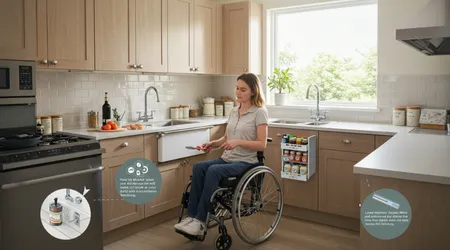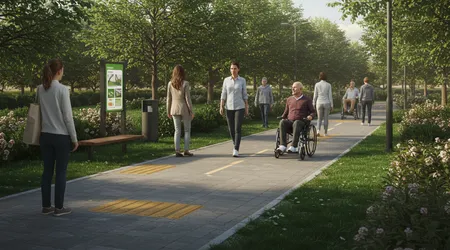Everyday Accessibility Hacks for Wheelchair Users

Accessibility hacks for wheelchair users transform daily challenges into manageable tasks, empowering independence in 2025’s evolving world.
Navigating urban spaces, homes, or workplaces often feels like solving a puzzle with missing pieces for the 1.2 million wheelchair users in the U.S. alone, according to the CDC’s 2024 disability report.
Yet, with creativity and practical strategies, barriers shrink.
This article dives into ingenious, real-world solutions rooted in lived experiences and current trends that enhance mobility, comfort, and autonomy.
From retrofitting your home to mastering city streets, these tips are designed to spark confidence and inspire action. Why settle for obstacles when you can outsmart them?
The goal here isn’t just to cope but to thrive. Each hack reflects a blend of practicality and innovation, tailored to wheelchair users’ unique needs.
Expect detailed, actionable advice, grounded in authenticity, with a touch of wit to keep it engaging. Let’s roll into a world where accessibility isn’t a buzzword it’s a lifestyle.
Adapting Your Home for Seamless Navigation
Home should be a sanctuary, not a maze. Accessibility hacks for wheelchair users start with rethinking your living space for fluidity and ease.
Widening doorways to at least 32 inches ensures smooth passage, per ADA guidelines. Consider lever-style door handles; they’re easier to grip than knobs.
A 2023 study by the National Institute on Disability found 68% of wheelchair users prioritized home modifications for independence.
Ramps are game-changers. Portable or modular ramps, available online, conquer small steps without costly renovations.
++ How to Make Your Kitchen More Accessible Without Renovating
For example, a foldable aluminum ramp can handle thresholds up to 6 inches. Clear clutter from hallways think of your floor as a runway, not a storage unit. Open space is freedom.
Lowering countertops to 30 inches or installing pull-out shelves maximizes kitchen access. Imagine prepping meals without straining pull-out shelves bring the pantry to you.
Smart home tech, like voice-activated lights, adds convenience. Picture saying, “Hey, Siri, light my path,” and it happens.

Mastering Urban Mobility with Confidence
Cities in 2025 pulse with possibility, but uneven sidewalks and crowded transit test patience. Accessibility hacks for wheelchair users turn urban jungles into navigable terrain.
Apps like AccessNow map accessible routes, pinpointing ramps and elevators in real time. For instance, a New Yorker might discover an elevator-equipped subway station nearby.
Portable wheelchair ramps, weighing as little as 10 pounds, tackle unexpected curbs. Carry one in a backpack for spontaneous outings.
Also read: Sensory gardens: benefits and how to create one at home
Another trick: scout venues online. Websites like Wheelmap.org detail accessibility features check before you go. It’s like having a reconnaissance team.
Public transit hacks include requesting priority seating via apps like Transit. In cities like Chicago, real-time bus accessibility updates are standard.
Always carry a lightweight tire repair kit; a flat tire mid-journey is nobody’s friend. Confidence comes from preparation.
Enhancing Comfort and Ergonomics On the Go
Comfort isn’t a luxury it’s a necessity. Accessibility hacks for wheelchair users prioritize ergonomics to prevent strain during long days.
Custom seat cushions, like ROHO’s air-filled models, distribute pressure evenly, reducing soreness.
A 2024 survey by the Christopher & Dana Reeve Foundation noted 72% of users reported less pain with proper cushioning.
Adjust your wheelchair’s footrests to align with your hips think of it as tuning a guitar for perfect harmony. A small mirror attached to the armrest helps spot obstacles behind you.
Picture navigating a busy mall without twisting your neck.
Read more: Accessibility in food delivery apps: a critical analysis
For cold weather, heated wheelchair blankets (USB-powered) keep you cozy. In summer, breathable mesh backrests prevent overheating.
These tweaks aren’t just hacks; they’re armor for daily adventures. Why let discomfort steal your focus?
Leveraging Technology for Independence
Tech in 2025 is a wheelchair user’s ally. Accessibility hacks for wheelchair users harness gadgets to amplify autonomy.
Smart wheelchairs, like Permobil’s M300, offer joystick precision and obstacle detection. They’re like self-driving cars for tight spaces. Costly, yes, but grants from organizations like the VA can help.
Voice-activated apps, such as Google Home, control home devices hands-free. Imagine adjusting your thermostat without moving an inch.
Wearable tech, like the Apple Watch, tracks vitals and sends emergency alerts. A user in Seattle might ping family if they’re stuck in an inaccessible spot.
Free apps like Lazarillo provide audio navigation for outdoor routes, describing intersections aloud. It’s like having a guide dog in your pocket. Tech isn’t just cool it’s a bridge to freedom.
Building Social and Community Connections
Isolation is a silent barrier. Accessibility hacks for wheelchair users foster connection in a world that sometimes overlooks mobility challenges.
Online platforms like Meetup host virtual accessibility-focused groups. A wheelchair user in Miami might join a local advocacy chat, sharing tips in real time.
In-person, seek venues with verified accessibility. Apps like OpenTable now flag wheelchair-friendly restaurants. Hosting at home?
Use modular furniture to create open spaces for guests. Picture a game night where everyone moves freely.
Advocacy amplifies connection. Joining groups like United Spinal Association puts you in touch with peers.
It’s like finding your tribe people who get it. Social bonds fuel resilience, turning challenges into shared victories.
Practical Hacks for Everyday Tasks
Daily tasks shouldn’t feel like marathons. Accessibility hacks for wheelchair users streamline routines with clever workarounds.
Long-reach grabbers, like the Vive Reacher, pick up items from high shelves. A user in Austin might snag a cereal box without a hassle.
Magnetic utensil holders keep kitchen tools within arm’s reach think of it as a culinary magnet board.
For dressing, zipper pulls with large loops simplify jackets. A quick tug, and you’re ready. These tools save time and energy.
Shopping? Use grocery delivery apps like Instacart, which let you specify accessible pickup spots.
Picture unloading groceries from a van ramp without juggling bags. Small tweaks, big wins every task becomes smoother.
Navigating Workplace Accessibility

Workplaces in 2025 are evolving, but gaps remain. Accessibility hacks for wheelchair users ensure productivity without barriers.
Request adjustable desks (29-30 inches high) to align with your wheelchair. Companies like IKEA offer affordable options.
A 2024 Bureau of Labor Statistics report noted 21% of disabled workers faced workplace accessibility issues.
Portable lap desks create instant workstations in non-ideal spaces. Imagine drafting emails comfortably in a cramped meeting room.
Noise-canceling earbuds, like Sony’s WF-1000XM5, block distractions in open offices.
Communicate needs early. Use templates from Job Accommodation Network to request modifications.
It’s like setting the stage before the show clarity prevents misunderstandings. Your workspace should empower, not hinder.
Table: Accessibility Hack Comparison
| Hack | Cost | Benefit | Example Use Case |
|---|---|---|---|
| Portable Ramp | $50-$200 | Conquers steps/curbs | Accessing a friend’s porch |
| Smart Wheelchair | $5,000-$15,000 | Precision navigation | Maneuvering crowded stores |
| Long-Reach Grabber | $10-$30 | Reaches high/low items | Grabbing a book from a shelf |
| Voice-Activated App | Free-$10 | Hands-free home control | Turning off lights from bed |
Example 1: The Coffee Shop Win
Last month, Sarah, a wheelchair user in Portland, faced an inaccessible coffee shop with a 4-inch step. She carried a lightweight ramp in her backpack, set it up in seconds, and rolled in confidently.
The barista, impressed, asked about the ramp, sparking a conversation about accessibility. Sarah’s hack didn’t just get her coffee it opened a dialogue.
Example 2: The Kitchen Hack
Mark, a Chicago resident, struggled to reach spices in his kitchen. He installed a magnetic strip on his lower cabinet, sticking metal spice tins within reach.
Now, cooking dinner feels like conducting an orchestra every tool is at his fingertips, no strain required.
Statistic
According to a 2024 CDC report, 13.7% of U.S. adults with mobility disabilities cited inaccessible environments as their top barrier to independence.
Analogy
Using accessibility hacks for wheelchair users is like equipping a spaceship for deep space. Each tool ramps, apps, grabbers propels you past obstacles, charting a course to freedom.
Conclusion: Empowerment Through Ingenuity
The journey of a wheelchair user in 2025 is a testament to resilience and resourcefulness. Accessibility hacks for wheelchair users aren’t just tricks they’re tools to rewrite the narrative of limitation.
From ramps that conquer curbs to apps that map accessible paths, these strategies empower you to live boldly.
The world may not always be built for wheels, but with creativity, it bends to your will.
Embrace these hacks as your toolkit for independence. Share them, adapt them, and keep pushing for a more accessible tomorrow.
After all, accessibility isn’t just about getting by it’s about thriving. What’s the next barrier you’ll outsmart?
Frequently Asked Questions
Q: How can I make my home more accessible on a budget?
A: Start with portable ramps ($50-$200) and lever handles ($10-$20). Clear clutter and use grabbers for high items. Check local grants for funding.
Q: Are there apps specifically for wheelchair users in 2025?
A: Yes, AccessNow and Wheelmap map accessible routes. Lazarillo offers audio navigation. Most are free or low-cost, updating in real time.
Q: How do I advocate for workplace accessibility?
A: Use Job Accommodation Network templates to request adjustable desks or ramps. Communicate needs clearly during onboarding. Persistence and documentation are key.
